2025-06-30
How do I respond to creditors?
Credit Counselling
Here are the ABC’s of dealing with creditors and debt collectors.
2017-04-17
We are approaching the end of April and with that, the deadline for filing your 2016 income taxes. It is a safe assumption that some percentage of the 36 million or so Canadians will owe money to the federal government after filing and will either not be able to pay their 2016 taxes, still owe money from prior years – or both. Being unable to pay one’s bills on time is certainly not a situation that anyone wants to find themselves in, regardless of who the creditor is. There are, however, several reasons why owing money to the CRA is a particularly bad situation to be in.

The first of these reasons starts with the interest carrying cost of taxes owing. Although interest rates are at historic lows, the CRA, by law, charges interest at higher levels. The interest rate charged by the CRA on overdue remittances is set quarterly. For each quarter, the interest rate charged on taxes owing is equal to the average treasury bill rate in effect plus four percent. For 2016, that interest rate is 5%. While the 5% rate is still lower than the interest rate charged on most credit card balances, it is the interest calculation method used by CRA which can greatly inflate the interest cost of having tax debts. Where an amount is owed to the CRA, interest charged on that amount is compounded daily, meaning that on each successive day, interest is being levied on the interest charged the day before. Not surprisingly, interest costs calculated by this method add up quickly.
The CRA also has a broad range of options at its disposal to compel payment. The CRA has the right, where there are any amounts owed to the taxpayer by any other department of the Federal Government, for example, GST credit or an Old Age Security payment, to in effect, seize those amounts and apply them to the tax debt. The CRA also has the authority to garnishee money owing to the taxpayer from a third party, such as an employer or client, or financial institution. Finally, the CRA can register a lien against the property of a taxpayer, thus effectively securing their interest by attaching repayment of the debt against the taxpayer’s residence.
When the amount of taxes due on filing can’t be paid or can’t be paid in full, it’s in the taxpayer’s best interest to contact the CRA and present the issue. The taxpayer can propose a payment schedule based on his or her ability to pay. If the CRA accepts the payment schedule, it is important to note that entering into such a payment arrangement does not stop the interest from accruing, as it will continue to be assessed at the current rate, and compounded daily.
If you are unable or do not have the means to satisfy the demands of the CRA, you might need to consider legal options so that you can protect your wages and assets. The legal means to stop the CRA is to file a Consumer Proposal or personal bankruptcy. It will have the effect of stopping any collection efforts by the CRA and will also stop further interest from accruing. Either of these options can only be administered by a Licensed Insolvency Trustee.
Contrary to popular notion, income tax debts are included in a Consumer Proposal or a personal bankruptcy. However, each of these forms of debt relief has special considerations with respect to the CRA and the settlement of tax debts.
A Consumer Proposal is a formal plan of arrangement where you can negotiate an agreement with the CRA, along with your other unsecured creditors to restructure your debt. You might be able to pay less than the full amount owing.
With bankruptcy, should the tax debt exceed $200,000 and represent 75% or more of the total indebtedness, a court hearing will be required to establish the terms of discharge from bankruptcy.
Finally, it is important to note that neither a Consumer Proposal nor a bankruptcy will remove a lien registered against a taxpayer’s property.
2025-06-30
Credit Counselling
Here are the ABC’s of dealing with creditors and debt collectors.
2025-06-02
Credit Counselling
With consumer debt at an all-time high, Canadians are being warned to take steps to reduce their debt before interest rates begin to rise.
2024-02-15
Credit Counselling
What are the right reasons to borrow money? Discover the guidelines to help you make a decision and learn how to avoid payday loans.